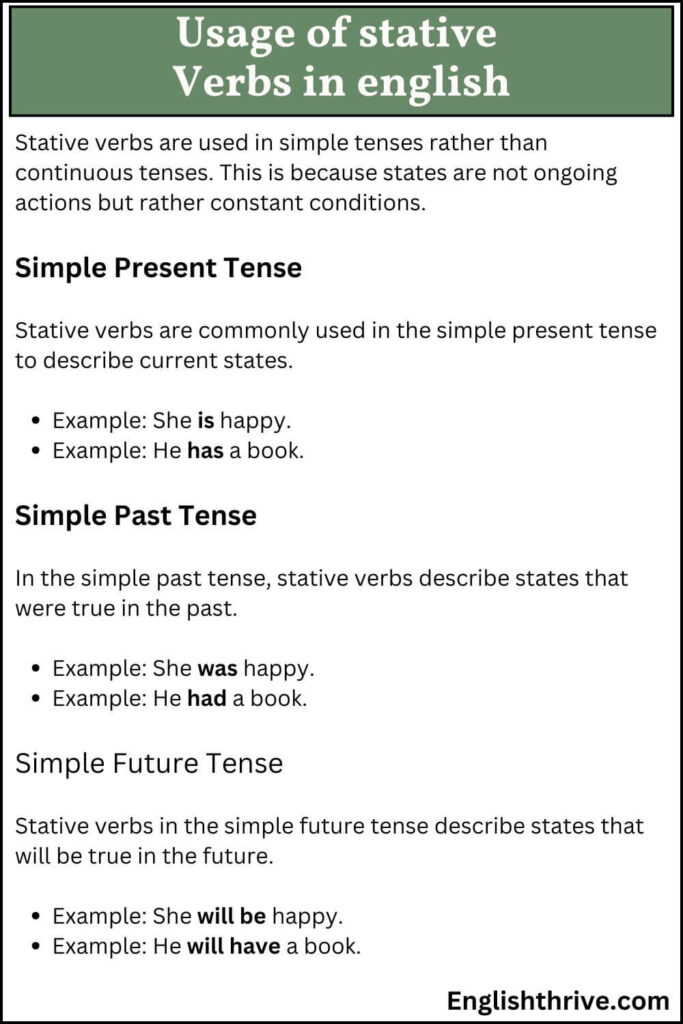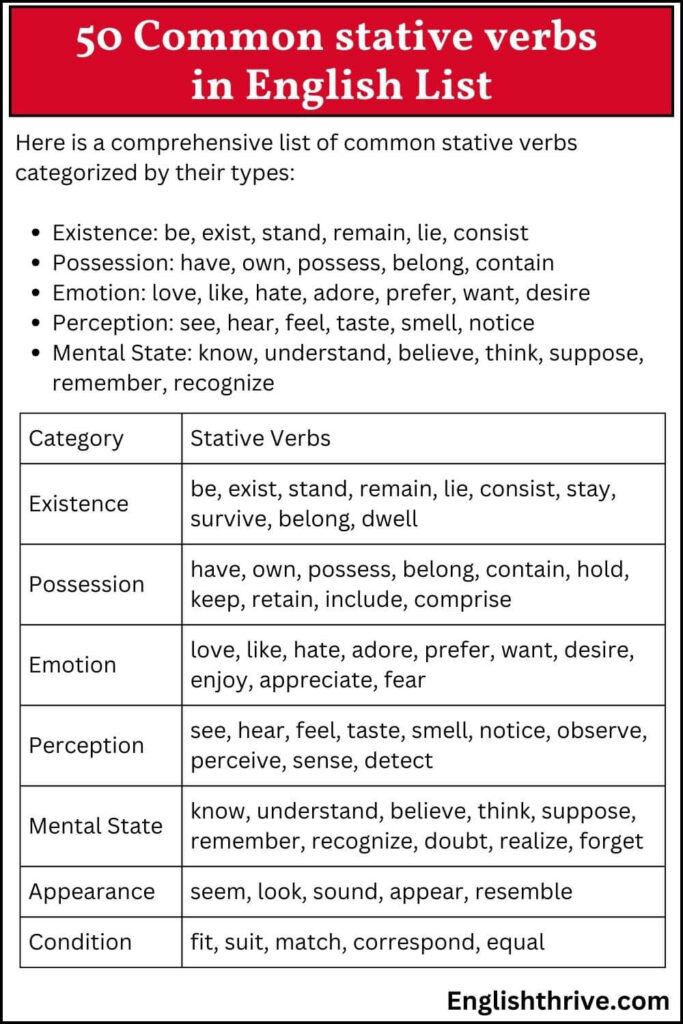Ever found yourself struggling to express feelings or describe a situation? Mastering Stative verbs in English can transform your communication, making it vivid and precise. As someone who’s navigated the complexities of English grammar, I’ve seen firsthand how understanding these verbs can enhance your language skills. Imagine describing a serene landscape or conveying deep emotions effortlessly. By exploring the nuances of stative verbs, you’ll unlock a new level of expression. Ready to dive deeper? Let’s explore practical tips and examples together!
What Are Stative Verbs? A Simple Definition
To grasp stative verbs, think of them as snapshots, not videos. They describe conditions or situations that linger rather than unfold.
-
- Definition: Stative verbs express a state of being, such as feelings, thoughts, ownership, or perceptions, rather than an action. Unlike dynamic verbs (run, jump, write), they don’t typically show progress or change over time.
-
- Key Trait – They rarely appear in continuous tenses (e.g., “I am knowing” sounds off because “know” is stative).
Picture someone saying, “I love this song.” The verb “love” doesn’t dance or shift—it holds steady, reflecting an unchanging emotion. Compare that to “I dance to this song,” where “dance” bursts with motion. That’s the heart of the difference.
Characteristics of Stative Verbs
- State Description: Stative verbs describe states of existence, such as being, possessing, or feeling.
- Non-Continuous: They are not usually used in continuous tenses (e.g., present continuous, past continuous).
- Perception and Emotion: Many stative verbs relate to senses, emotions, and mental states.
Examples of stative verbs in english
Stative verbs include a wide range of words that describe various states. Some common examples are:
- Existence: be, exist, stand, remain
- Possession: have, own, possess, belong
- Emotion: love, like, hate, fear
- Perception: see, hear, feel, taste, smell
- Mental State: know, understand, believe, think
Types of stative verbs in english
Stative verbs can be categorized based on the type of state they describe. Understanding these categories helps in identifying and using stative verbs correctly.
1. Verbs of Existence and Possession
These verbs describe the state of being or having something. They are fundamental in expressing basic conditions.
- Existence: be, exist, live, survive
- Example: She is a doctor.
- Possession: have, own, possess, belong
- Example: He has a car.
2. Verbs of Emotion and Preference
These verbs express feelings, emotions, and preferences, which are states of mind.
- Emotion: love, like, hate, adore
- Example: I love chocolate.
- Preference: prefer, want, desire, wish
- Example: She prefers tea over coffee.
3. Verbs of Perception and Senses
These verbs relate to the five senses and describe how we perceive the world.
- Sight: see, notice, observe
- Example: I see a bird in the sky.
- Hearing: hear, listen, detect
- Example: He hears music playing.
- Touch: feel, touch, sense
- Example: She feels the soft fabric.
- Taste: taste, savor
- Example: He tastes the sweet cake.
- Smell: smell, scent, detect
- Example: She smells the fresh flowers.
4. Verbs of Mental State and Cognition
These verbs describe mental states, thoughts, and beliefs, which are internal states.
- Knowledge: know, understand, recognize
- Example: He knows the answer.
- Belief: believe, think, suppose
- Example: She believes in hard work.
- Memory: remember, recall, forget
- Example: I remember my childhood.

Usage of stative verbs in english
Stative verbs are used in simple tenses rather than continuous tenses. This is because states are not ongoing actions but rather constant conditions.
Simple Present Tense
Stative verbs are commonly used in the simple present tense to describe current states.
- Example: She is happy.
- Example: He has a book.
Simple Past Tense
In the simple past tense, stative verbs describe states that were true in the past.
- Example: She was happy.
- Example: He had a book.
Simple Future Tense
Stative verbs in the simple future tense describe states that will be true in the future.
- Example: She will be happy.
- Example: He will have a book.
Exceptions to the Rule
While stative verbs are generally not used in continuous tenses, there are exceptions where they can be used to describe temporary or changing states.
- Example: I am loving this movie. (temporary emotion)
- Example: She is being quiet today. (temporary behavior)
Common Mistakes with stative verbs in english
Learners often make mistakes with stative verbs, particularly in tense usage. Understanding these common errors can help improve accuracy.
- Using Continuous Tenses: Incorrectly using stative verbs in continuous tenses.
- Incorrect: She is having a car.
- Correct: She has a car.
- Confusing Stative and Dynamic Verbs: Mistaking stative verbs for dynamic verbs.
- Incorrect: He is knowing the answer.
- Correct: He knows the answer.
Practical Examples of stative verbs in english
To solidify understanding, let’s explore practical examples of stative verbs in various contexts.
- Existence: The tree stands tall in the garden.
- Possession: She owns a beautiful house.
- Emotion: He loves his family.
- Perception: I see a rainbow in the sky.
- Mental State: She understands the concept.
Stative Verbs vs. Dynamic Verbs
Stative verbs differ significantly from dynamic verbs, which describe actions or processes. Understanding this distinction is crucial for accurate verb usage in English.
Dynamic Verbs
Dynamic verbs, also known as action verbs, express activities, processes, or changes. They are used in continuous tenses to describe ongoing actions.
- Examples: run, eat, write, play, work
- Usage: I am running in the park.
Differences
- Tense Usage: Stative verbs are typically used in simple tenses, while dynamic verbs can be used in both simple and continuous tenses.
- State vs. Action: Stative verbs describe states, whereas dynamic verbs describe actions or processes.
- Temporary vs. Permanent: Stative verbs often describe permanent or long-term states, while dynamic verbs can describe temporary actions.
Comparative Examples
Let’s compare stative and dynamic verbs in similar contexts to highlight their differences.
-
Stative: She is happy. (describes a state of emotion)
-
Dynamic: She is smiling. (describes an action showing happiness)
-
Stative: He has a book. (describes a state of possession)
-
Dynamic: He is reading a book. (describes an action involving the book)
Advanced Usage of stative verbs in english
While the basic usage of stative verbs is straightforward, there are advanced scenarios where understanding nuances can enhance communication.
Temporary States with stative verbs in english
Although stative verbs generally describe permanent states, they can be used in continuous tenses to emphasize temporary or changing states.
- Example: I am loving this weather today. (temporary emotion)
- Example: She is being quiet this morning. (temporary behavior)
stative verbs in english with Modal Auxiliaries
Stative verbs can be used with modal auxiliaries (e.g., can, may, must) to express ability, possibility, or obligation related to states.
- Example: She must be happy with her new job.
- Example: He can see the difference now.
stative verbs in english in Passive Voice
Stative verbs can also be used in the passive voice to describe states that are the result of an action.
- Example: The cake is loved by everyone.
- Example: The book is known for its insights.
Distinguishing Stative Verbs in Context
Understanding the context is essential for correctly identifying and using stative verbs. Here are some tips for distinguishing stative verbs in various contexts.
Contextual Clues
- Emotional or Mental States: Look for words that describe feelings, thoughts, or perceptions.
- Possession or Existence: Identify verbs that describe having or being.
- Sensory Descriptions: Recognize verbs related to the five senses.
Ambiguous Verbs
Some verbs can be both stative and dynamic, depending on the context. Recognizing these verbs requires careful attention to their usage.
-
Example: Have can be stative (possession) or dynamic (action of consuming).
- Stative: She has a car.
- Dynamic: She is having dinner.
-
Example: See can be stative (perception) or dynamic (action of meeting).
- Stative: I see the mountain.
- Dynamic: I am seeing a doctor tomorrow.
Mastering stative verbs in english
To master stative verbs, practice is key. Engaging in conversations, reading, and writing exercises can help reinforce understanding and usage.
Practice Tips
- Identify Stative Verbs: Regularly identify stative verbs in texts and conversations.
- Use Simple Tenses: Practice using stative verbs in simple tenses.
- Explore Exceptions: Understand and practice exceptions where stative verbs can be used in continuous tenses.

50 Common stative verbs in english List
Here is a comprehensive list of common stative verbs categorized by their types:
- Existence: be, exist, stand, remain, lie, consist
- Possession: have, own, possess, belong, contain
- Emotion: love, like, hate, adore, prefer, want, desire
- Perception: see, hear, feel, taste, smell, notice
- Mental State: know, understand, believe, think, suppose, remember, recognize
| Category | Stative Verbs |
|---|---|
| Existence | be, exist, stand, remain, lie, consist, stay, survive, belong, dwell |
| Possession | have, own, possess, belong, contain, hold, keep, retain, include, comprise |
| Emotion | love, like, hate, adore, prefer, want, desire, enjoy, appreciate, fear |
| Perception | see, hear, feel, taste, smell, notice, observe, perceive, sense, detect |
| Mental State | know, understand, believe, think, suppose, remember, recognize, doubt, realize, forget |
| Appearance | seem, look, sound, appear, resemble |
| Measurement | weigh, measure, cost, contain, hold |
| Opinion | agree, disagree, matter, care, mind |
| Relationship | involve, concern, include, consist, comprise |
| Condition | fit, suit, match, correspond, equal |
Conclusion
Stative verbs in English are fundamental to expressing states of being, emotion, perception, and mental states in English. By understanding their types, usage, and distinctions from dynamic verbs, learners can significantly improve their language skills. Practicing with various contexts and exploring advanced usage scenarios can further enhance proficiency. In the final section, we will summarize the key points and provide actionable tips for continued learning.
FAQs On stative verbs in english
1. What are stative verbs, and how do they differ from dynamic verbs?
- Stative verbs describe states of being, emotion, perception, or possession, while dynamic verbs describe actions or processes. Stative verbs are typically used in simple tenses, whereas dynamic verbs can be used in both simple and continuous tenses.
2. Can stative verbs ever be used in continuous tenses?
- While stative verbs are generally not used in continuous tenses, there are exceptions. They can be used to describe temporary or changing states. For example, “I am loving this movie” emphasizes a temporary emotion.
3. How can I improve my understanding and usage of stative verbs?
- Practice identifying stative verbs in reading materials and conversations. Use them in simple tenses and explore exceptions where they can be used in continuous tenses. Engage in contexts that require expressing states, such as describing emotions or perceptions.
4. What are some common mistakes learners make with stative verbs?
- Common mistakes include using stative verbs in continuous tenses incorrectly and confusing stative verbs with dynamic verbs. For example, saying “She is having a car” instead of “She has a car” is incorrect.
5. How do modal auxiliaries work with stative verbs?
- Stative verbs can be used with modal auxiliaries like “can,” “may,” and “must” to express ability, possibility, or obligation related to states. For example, “She must be happy with her new job” uses a modal auxiliary with a stative verb.
6. What are some practical examples of stative verbs in different contexts?
- Examples include:
- Existence: The tree stands tall in the garden.
- Possession: She owns a beautiful house.
- Emotion: He loves his family.
- Perception: I see a rainbow in the sky.
- Mental State: She understands the concept.

